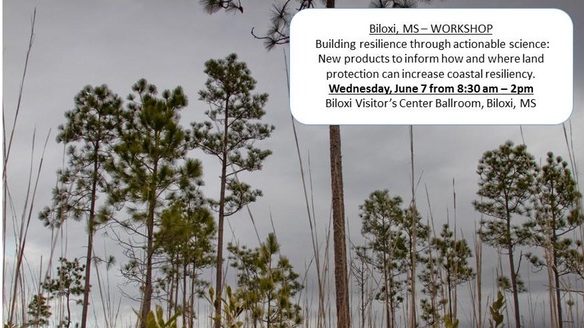Building Resilience Through Actionable Science Workshops

Work funded by the Southeast Climate Science Center, South Central Climate Science Center, and Gulf Coastal Plains & Ozarks Landscape Conservation Cooperative, Landscape Conservation Design for Enhancing the Adaptive Capacity of Coastal Wetlands in the Face of Sea-level Rise and Coastal Development, by Principal Investigator Michael Osland of U.S. Geological Survey’s Wetland and Aquatic Research Center (WARC) will be featured in several upcoming workshops on Building resilience through actionable science: New products to inform how and where land protection can increase coastal resiliency. The workshops, organized by WARC and the Nature Conservancy’s Gulf of Mexico Whole Systems Program (TNC), are designed to share with stakeholders the findings from their work on tidal saline wetland migration and from TNC’s work on open space protection in the Gulf area, to engage discussion of potential applications of these in land use, conservation, and flood mitigation planning, and to solicit input on the customization and use of these products for decision making.
Workshop objectives are to:
• Share the Open Space and Tidal Saline Wetland Migration findings with a diverse group of end users and facilitate a discussion about how outputs can be used to increase coastal resilience.
• Review both datasets on Coastal Resilience 2.0 to generate discussion of local use of land protection for flood risk reduction and how wetland migration data could affect decision making.
• Solicit input from attendees on what planning processes or decisions could be impacted by the open space and wetland migration projects and what next steps or custom products would be most useful to support these efforts.
Open Space – The Nature Conservancy
TNC partnered with Dr. Sam Brody and Dr. Wes Highfield, both of Texas A&M University, to identify which watersheds across the Gulf coast are the best targets for strategic land conservation to both reduce flood risk and conserve biodiversity. The analysis identified 421 watersheds along the Gulf of Mexico that have both high likelihood of flood damages and high conservation value. A selection of these watersheds is being targeted for workshops devoted to a discussion of open space protection as a flood risk reduction and conservation strategy.
Coastal Wetland Migration – USGS
In the 21st century, accelerated sea-level rise and continued coastal development are expected to greatly alter coastal landscapes across the globe. In a recent study, Dr. Michael Osland, Nicholas Enwright, and Kereen Griffith identified areas where tidal saline wetlands may adapt via landward migration along the northern Gulf of Mexico coast. These analyses provided information that can be used to identify migration corridors and develop future-focused sea-level rise adaptation strategies that will improve the potential that the ecosystem goods and services provided by these wetlands will continue to be available for future generations.
Workshops are free but space is limited and registration is required. They are being held on May 23 in Punta Gorda, FL, on June 6 in Lake Charles, LA, and on June 7 in Biloxi, MS. Follow the location links for more information and to register.